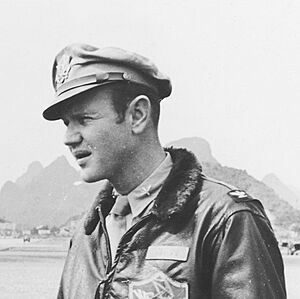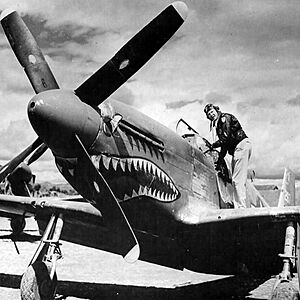Tex Hill facts for kids
Quick facts for kids
David Lee Hill
|
|
|---|---|

Colonel "Tex" Hill in 1944
|
|
| Nickname(s) | "Tex" |
| Born | July 13, 1915 Gwangju, Korea under Japanese rule (now South Korea) |
| Died | October 11, 2007 (aged 92) Terrell Hills, Texas, United States |
| Allegiance | United States |
| Service/ |
United States Navy Republic of China Air Force United States Army Air Forces United States Air Force Reserve |
| Years of service | 1939–1968 |
| Rank | Brigadier General |
| Unit | Flying Tigers |
| Commands held | 58th Fighter Wing 412th Fighter Group 23rd Fighter Group 1st Proving Ground Group 75th Fighter Squadron |
| Battles/wars | World War II Korean War |
| Awards | Distinguished Service Cross Legion of Merit Distinguished Flying Cross (3) Air Medal (2) Order of the Cloud and Banner (China) Distinguished Flying Cross (United Kingdom) |
David Lee "Tex" Hill (born July 13, 1915 – died October 11, 2007) was a brave American fighter pilot. He was known as a "triple flying ace" because he shot down many enemy planes. During World War II, he achieved 12+1⁄4 victories while leading a squadron with the famous Flying Tigers. He also had six more victories as an officer in the U.S. Army Air Corps. Tex Hill retired from the military as a brigadier general.
Contents
Early Life of Tex Hill
Tex Hill was born in Gwangju, Korea, on July 13, 1915. He was the youngest of four children. His parents were Presbyterian missionaries, which means they traveled to spread their religious beliefs. When Tex was just 15 months old, his family moved back to the United States. They eventually settled in San Antonio, Texas. His father became a minister at the First Presbyterian Church there.
Tex went to San Antonio Academy and then McCallie School. While at McCallie, he won the Tennessee Middleweight Championship in boxing in 1934. After high school, he studied at Texas A&M and then graduated from Austin College in 1938.
His very first flight happened when he was young. He and a friend snuck out of church and used their collection money to pay for a ride in a plane!
Tex Hill's Military Career
After finishing college in 1938, Tex Hill joined the United States Navy. He became a Naval Aviator, which means he learned to fly planes for the Navy. By November 1939, he earned his pilot's wings. He started as a pilot flying TBD Devastator torpedo bombers from the aircraft carrier USS Saratoga. Later, he flew Vought SB2U Vindicator dive bombers from the USS Ranger.
World War II Heroics
In 1941, Tex Hill was chosen along with other skilled pilots from the Navy, Army, and Marine Corps to join a special group. This group was called the 1st American Volunteer Group (AVG), but they became much more famous as the Flying Tigers. He traveled to Burma (now Myanmar) and arrived there in September 1941. He trained to fly the P-40 fighter plane. Tex quickly became a top pilot in the "Panda Bears" squadron, first as a flight leader and then as the squadron commander. He learned a lot from their leader, Claire Chennault.
Tex Hill got his first victories on January 3, 1942, when he shot down two Japanese planes over Thailand. He shot down two more planes later that month. On January 24, he became an "ace" by shooting down a fifth enemy plane over Rangoon. In March, he took over as the leader of the Second Squadron. By the time the Flying Tigers group was stopped in the summer of 1942, Tex Hill was a "double ace," meaning he had shot down 12+1⁄4 enemy planes.
On May 7, 1942, the Japanese Army started building a bridge across the Salween River. This bridge would let them move soldiers and supplies into China. Tex Hill led four P-40E planes to bomb and attack the bridge. For the next four days, the Flying Tigers flew many missions, stopping the Japanese forces. The Japanese never got past the west side of the Salween River. Claire Chennault later said that the Flying Tigers had saved China from collapsing.
On Thanksgiving Day in 1943, Tex Hill led a large group of planes on a mission to Formosa (now Taiwan). His group included 12 B-25 bombers, 10 P-38 fighters, and 8 new P-51 fighters. They attacked Shinchiku Airfield, where the Japanese had many planes. The enemy managed to get only seven fighters into the air, and these were quickly shot down. The American forces destroyed 42 Japanese planes and likely destroyed 12 more. All the American planes returned safely.
After the Flying Tigers were officially stopped in July 1942, Tex Hill was one of only five pilots who joined the new United States Army Air Forces (USAAF) group, the 23rd Fighter Group. He became a major. He helped start the 75th Fighter Squadron and later commanded the entire 23rd Fighter Group as a colonel. Before he returned to the U.S. in late 1944, Tex Hill shot down six more Japanese planes with his P-51.
It is believed that he was the first pilot to shoot down a Japanese Zero plane using a P-51. Overall, Tex Hill was credited with destroying 18.25 enemy aircraft. The ".25" means he helped shoot down one plane with three other pilots.
After World War II
In 1944, Tex Hill came back to the United States. He took command of the 412th Fighter Group, which was the first group in America to fly jet fighter planes like the P-59 Airacomet and the P-80 Shooting Star. He left active military service in 1945.
In July 1946, the governor of Texas asked Tex Hill to lead the 136th Fighter Group of the Texas Air National Guard. Tex Hill helped start Guard units all along the Gulf Coast. He became the youngest brigadier general in the history of the Air National Guard. During the Korean War, he continued to serve with the Texas Air National Guard.
He finished his military career in the Air Force Reserve, retiring as a brigadier general.
Later Life and Honors
In 1999, Tex Hill was honored by being added to the Texas Aviation Hall of Fame in Houston. In 2006, he was also inducted into the National Aviation Hall of Fame.
In 2002, he was given an honorary lifetime membership in the U.S. Air Force Auxiliary, also known as the Civil Air Patrol. A squadron of the Civil Air Patrol in San Marcos, Texas, was named the Tex Hill Composite Squadron in his honor. This squadron grew to be very large and received many awards.
Tex Hill passed away on October 11, 2007, at the age of 92, in Terrell Hills, Texas. More than 2,000 people attended his funeral. He was buried at Fort Sam Houston National Cemetery.
On November 2, 2007, the National Museum of the Pacific War in Fredericksburg held a "Tex" Hill Day. They had speeches, patriotic music, and friends shared memories of the hero.
On November 2, 2008, an Air Force Heritage Flight at the Lackland AFB Air Show in San Antonio was dedicated to Tex Hill. It featured modern fighter jets like the F-22, F-15E, and F-16C, along with a P-40 plane, just like the one Tex Hill flew with the Flying Tigers.
In June 2013, Middle School 14 in San Antonio was named "Hill Middle School" in his honor.
Awards and Decorations
Tex Hill received many important awards during his military career. These include the Distinguished Service Cross, the Distinguished Flying Cross (with two oak leaf clusters), and the Presidential Unit Citation. He also received awards from other countries, such as the Chinese Order of the Cloud and Banner and the British Distinguished Flying Cross.
Personal Life
Tex Hill met Mazie Sale at the First Presbyterian Church in Victoria, Texas. He was on leave, recovering from malaria. They married on March 27, 1943, and stayed together until his death.
Images for kids



